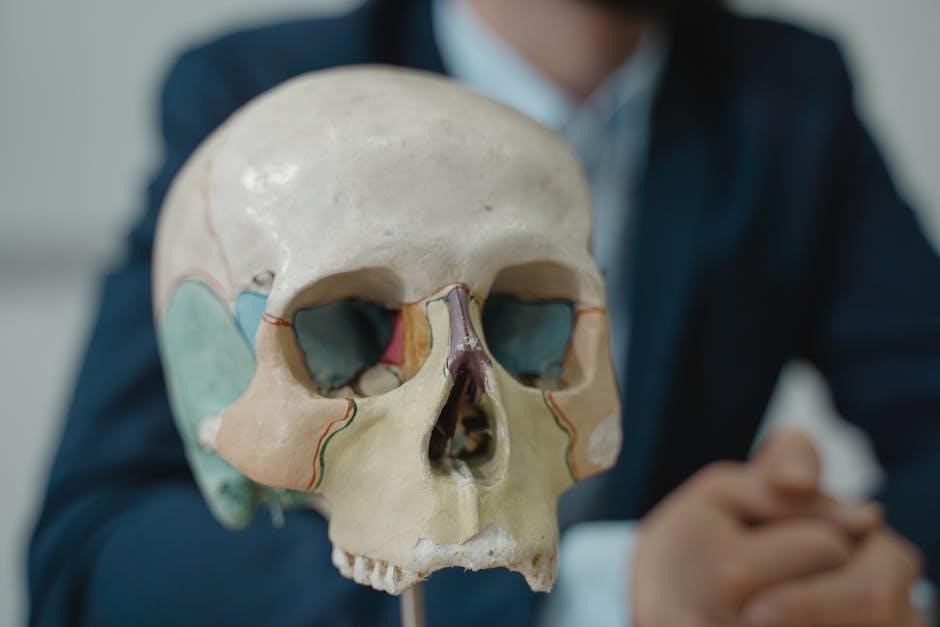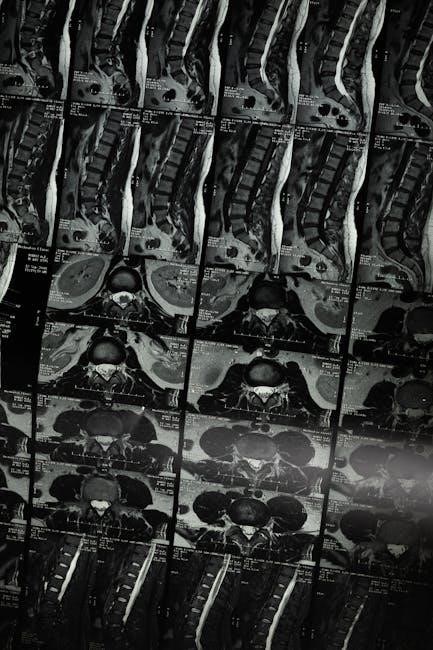Anatomy and physiology are foundational sciences studying the structure and function of the human body. Anatomy focuses on physical structures, while physiology explores their functions and processes. Together, they provide a comprehensive understanding of how the body operates, essential for healthcare and biological sciences.
1.1 Definition of Anatomy and Physiology
Anatomy is the scientific study of the body’s structure, focusing on the organization and relationships of organs, tissues, and cells. Physiology examines the functions and processes that enable the body to maintain life. Together, they provide a comprehensive understanding of how the body works, from cellular mechanisms to systemic interactions. This dual approach is essential for understanding health, disease, and the human body’s intricate systems.
1.2 Importance of Studying Anatomy and Physiology
Studying anatomy and physiology is crucial for understanding how the human body functions. It forms the foundation for healthcare professions, enabling effective diagnosis and treatment. This knowledge also promotes a deeper appreciation of health and wellness, empowering individuals to make informed decisions. Additionally, it supports advancements in medical research and technology, driving innovation in therapies and treatments. Thus, anatomy and physiology are essential for both personal and professional applications in the health sciences.
1.3 Overview of the Human Body Structure
The human body is organized into a hierarchical structure, beginning with cells, which form tissues, then organs, and finally systems. This organization allows for specialized functions and efficient communication between components; The body’s systems, such as skeletal, muscular, and nervous, work together to maintain homeostasis and overall health. Understanding this structure is vital for grasping how the body functions as a whole and for diagnosing and treating medical conditions effectively. This foundational knowledge is essential for healthcare professionals and students alike.

Levels of Organization in the Human Body
The human body is organized into cells, tissues, organs, and systems, each level building on the previous to maintain overall function and health.
2.1 Cellular Level
The cellular level is the most basic unit of life in the human body. Cells are specialized to perform specific functions, forming the foundation for all biological processes. Each cell contains essential components like the nucleus, mitochondria, and ribosomes, which are vital for energy production, protein synthesis, and genetic control. Understanding cell structure and function is crucial for grasping higher levels of organization, as all tissues, organs, and systems originate from cellular activity. This fundamental level underpins anatomy and physiology.
2.2 Tissue Level
The tissue level represents a group of similar cells that work together to perform specific functions. There are four primary types of tissues: epithelial, connective, muscle, and nervous. Epithelial tissues form barriers and linings, while connective tissues provide support and structure. Muscle tissues enable movement, and nervous tissues transmit signals. Understanding tissues is essential for comprehending how organs and systems develop and function. This level bridges cells and organs, forming the foundation of complex bodily structures and processes.
2.3 Organ Level
The organ level consists of structures formed by two or more types of tissues working together to perform specific functions. Organs like the heart, lungs, and liver are specialized to execute complex tasks essential for survival. Each organ’s unique structure and function contribute to the overall integrity of the body. Organs are the building blocks of organ systems, which collectively maintain homeostasis and enable the body to operate as a unified whole. This level emphasizes functional specialization and integration.
2.4 System Level
The system level is the highest level of organization, where organs and tissues collaborate as integrated systems to maintain overall bodily functions. Systems like the circulatory, respiratory, and nervous systems work interdependently to ensure homeostasis. Each system has a unique role but relies on others for complete functionality. This level highlights the interconnectedness of body systems and their collective role in sustaining life and enabling complex processes, demonstrating the body’s intricate and harmonious design. This level emphasizes systemic interdependence and holistic function.

Branches of Anatomy and Physiology
Anatomy and physiology are divided into branches like systemic, regional, developmental, microscopic, and applied physiology, each offering unique perspectives on the human body’s structure and functions.
3.1 Systemic Anatomy
Systemic anatomy focuses on the study of specific organ systems, such as the skeletal, muscular, and nervous systems. It examines how these systems are structured and interconnected, providing a detailed understanding of their functions within the body. This branch is crucial for healthcare professionals, as it aids in diagnosing and treating conditions. Resources like anatomy and physiology study guides and PDF workbooks often include systemic anatomy sections, offering visual aids and exercises to enhance learning.
3.2 Regional Anatomy
Regional anatomy involves studying specific body regions, such as the head, neck, or abdomen, focusing on the relationships between structures within each area. This approach is practical for medical professionals, as it mirrors how conditions are diagnosed and treated in clinical settings. Study guides and PDF resources often include detailed regional anatomy sections, offering labeled diagrams and dissection guides to help learners visualize and understand spatial relationships between organs, tissues, and systems.
3.3 Developmental Anatomy
Developmental anatomy explores the formation and growth of the body from embryonic stages through adulthood. It examines the sequential development of organs and systems, emphasizing how structures change over time. Study guides often include detailed timelines and stages of embryogenesis, providing insights into normal and abnormal development. This branch is crucial for understanding congenital conditions and the progression of physiological processes, making it a key area of study in anatomy and physiology.
3.4 Microscopic Anatomy
Microscopic anatomy delves into the study of tissues and cells, examining structures invisible to the naked eye. It uses techniques like histology and cytology to analyze the arrangement and function of cellular components. Study guides often include high-resolution images and detailed descriptions of tissue types, aiding in the identification of normal and pathological structures. This branch is essential for understanding disease mechanisms and diagnosing conditions at the cellular level.
3.5 Applied Physiology
Applied physiology focuses on the practical application of physiological principles to real-world scenarios, particularly in fields like medicine, nursing, and rehabilitation. It explores how bodily functions respond to stress, disease, or environmental changes. Study guides often include clinical case studies and diagrams to illustrate how physiological processes apply in healthcare settings. This branch bridges the gap between theoretical knowledge and practical solutions, aiding professionals in diagnosing and treating disorders effectively.

The Skeletal System
The skeletal system consists of bones, joints, and ligaments, providing structural support, protection, and movement. It also produces blood cells and stores minerals like calcium.
4.1 Structure and Function of Bones
Bones are dynamic tissues that provide structural support, protect internal organs, and facilitate movement. They consist of a dense outer layer (cortex) and a spongy inner layer (medulla). The periosteum, a fibrous membrane, covers the bone surface, aiding in growth and repair. Bones also store minerals like calcium and phosphorus, essential for mineral balance. Their functions include blood cell production in the marrow and acting as attachment points for muscles, enabling mobility and maintaining body posture.
4.2 Classification of Joints
Joints, or articulations, are classified based on their ability to move. There are three main types: synarthroses (immovable), amphiarthroses (slightly moveable), and diarthroses (freely moveable). Synarthroses, like the sutures in the skull, allow no movement. Amphiarthroses, such as intervertebral discs, permit limited movement. Diarthroses, including hinge and ball-and-socket joints, enable extensive movement. This classification helps understand joint functions and their role in facilitating various types of body movements.
4.3 Disorders of the Skeletal System
The skeletal system can be affected by various disorders, such as osteoporosis, fractures, and rickets. Osteoporosis weakens bones due to calcium and vitamin D deficiencies. Fractures occur when bones break under stress or trauma. Rickets, caused by insufficient vitamin D, affects bone development in children. Other conditions include scoliosis (spinal curvature) and osteogenesis imperfecta (brittle bone disease). These disorders impact mobility and overall health, emphasizing the importance of understanding skeletal health for prevention and treatment.

The Muscular System
The muscular system consists of skeletal, smooth, and cardiac muscles, enabling movement, maintaining posture, and performing involuntary functions like digestion and circulation, vital for overall health.
5.1 Types of Muscles
The muscular system comprises three primary types of muscles: skeletal, smooth, and cardiac. Skeletal muscles are voluntary, attached to bones, and enable movement. Smooth muscles are involuntary, found in organs like the digestive tract, and facilitate functions like peristalsis. Cardiac muscle is specialized for the heart, ensuring rhythmic contractions to pump blood. Each type varies in structure, function, and control, working harmoniously to maintain bodily functions and overall health. Understanding these differences is crucial for studying anatomy and physiology effectively.
Muscle structure and function are intricately linked to facilitate movement and support bodily processes. Muscles are composed of muscle fibers, which contain myofibrils made of actin and myosin filaments. These filaments slide past each other during contraction, enabled by motor neurons transmitting signals. Tendons connect muscles to bones, while ligaments provide stability. Muscles function to produce movement, maintain posture, regulate body temperature, and assist in circulation. Their structure ensures efficiency and precision in performing these vital functions, making them essential for overall bodily mechanics and health. Common muscular disorders include Muscular Dystrophy, a genetic condition causing progressive muscle weakness, and Myasthenia Gravis, an autoimmune disease affecting nerve-muscle communication. Fibromyalgia is characterized by widespread muscle pain and tenderness. Tendinitis involves inflammation of tendons, often due to injury or overuse. Additionally, muscle strains and spasms are frequent issues. Understanding these disorders is crucial for accurate diagnosis and effective treatment, emphasizing the importance of studying muscular anatomy and physiology. The nervous system, comprising the central and peripheral divisions, regulates, coordinates, and controls bodily functions and responses, enabling adaptation and interaction with the environment. The nervous system consists of the central nervous system (CNS), including the brain and spinal cord, and the peripheral nervous system (PNS), which includes nerves and ganglia. The CNS processes information and controls responses, while the PNS transmits signals between the CNS and the body. Neurons, specialized cells, form the functional units, supported by glial cells. The PNS is further divided into sensory (afferent) and motor (efferent) nerves, enabling communication and response. This structure allows for complex coordination and adaptability. The nervous system performs essential functions, including control and coordination of body activities, regulation of internal processes, and facilitation of communication between different body parts. It enables sensory perception, allowing individuals to interpret stimuli, and motor responses, enabling movement and action. Additionally, it regulates involuntary functions, such as heart rate and digestion, and supports cognitive processes, including memory, learning, and emotions. These functions are vital for maintaining homeostasis and overall body functionality. The nervous system can be affected by various disorders, including neurodegenerative diseases like Alzheimer’s and Parkinson’s, which impair brain function. Demyelinating diseases, such as multiple sclerosis, disrupt nerve signal transmission. Infections like meningitis and encephalitis can cause inflammation and damage. Additionally, conditions like epilepsy and stroke affect nervous system functionality. These disorders often result in cognitive, motor, or sensory impairments, highlighting the importance of understanding their causes, symptoms, and treatments in anatomy and physiology studies. Anatomy and Physiology study guides are available as PDFs, offering comprehensive notes and diagrams. Coloring workbooks enhance learning through interactive exercises. Online resources, including simulations and videos, provide hands-on experience, aiding visual learners and reinforcing complex concepts effectively. Anatomy and Physiology coloring workbooks are interactive tools that help students visualize and memorize complex structures. By coloring diagrams, learners engage actively, improving retention of anatomical details. These workbooks often cover various systems, from skeletal to nervous, and include labeling exercises. They are particularly effective for visual learners, making abstract concepts more tangible. Regular use enhances spatial awareness and prepares students for dissections and clinical applications. This hands-on approach fosters deeper understanding and reinforces textbook material. Online study guides and PDF resources offer comprehensive and accessible materials for anatomy and physiology students; These resources often include detailed notes, diagrams, and practice questions, covering topics from cellular structures to systemic functions. Many guides are designed for interactive learning, with features like quizzes and simulations. PDF formats allow easy downloading and offline access, making them ideal for flexible study routines. They cater to diverse learning styles, providing visual, textual, and practical content to enhance understanding and retention of complex biological concepts. Interactive simulations and videos are powerful tools for visualizing complex anatomical and physiological processes. They allow students to explore 3D models, observe dynamic functions, and engage with interactive content. Videos often demonstrate dissections, organ systems, and cellular activities, making abstract concepts more tangible. Simulations enable hands-on practice, such as virtual labs or muscle movement animations. These resources enhance understanding, cater to visual learners, and provide an engaging alternative to traditional study methods, making them invaluable for modern anatomy and physiology education.
Effective study techniques involve active learning, creating structured schedules, and utilizing tools like flashcards and mnemonics. These methods enhance retention and understanding of complex topics, ensuring success. Creating a study schedule is essential for managing time effectively. Allocate specific periods for each topic, ensuring a balanced approach. Prioritize challenging subjects and integrate regular breaks. Consistency is key to retaining information. Use planners or digital tools to stay organized. Regularly review and adjust the schedule to accommodate progress and identify areas needing more focus. A well-structured plan fosters discipline and maximizes learning efficiency, helping to achieve academic goals successfully. Stay committed to the schedule to ensure steady progress and comprehensive understanding. Active learning involves engaging directly with content to enhance understanding. Techniques include group discussions, problem-solving, and hands-on activities. Use flashcards to test knowledge and reinforce memory. Participate in interactive simulations to visualize complex processes. Apply concepts through case studies or lab work. Teach others to deepen comprehension. Regular self-assessment helps identify gaps. Incorporate real-world examples to connect theory with practical applications. These strategies promote critical thinking and improve retention, making learning more effective and enjoyable. Consistent practice strengthens mastery of anatomy and physiology concepts. Flashcards are effective tools for memorizing key terms and concepts in anatomy and physiology. Write terms on one side and definitions or explanations on the other. Mnemonics, such as acronyms or rhymes, help remember complex information. For example, “Every Good Boy Does Fine” aids in recalling musical notes. Use these methods to create mental associations and enhance retention. Regular review of flashcards and practice of mnemonics improve understanding and prepare for exams efficiently. These strategies are simple yet powerful for mastering challenging topics. Effective exam preparation involves understanding formats, practicing past papers, and managing stress. Utilize study guides, PDF resources, and online tools to enhance your readiness and confidence. Understanding exam formats is crucial for effective preparation. Familiarize yourself with question types, such as multiple-choice, true/false, and essay questions. Review study guides and PDF resources to identify key sections frequently tested. Recognize the structure and content emphasis in past papers to focus your study efforts. Utilize online platforms and practice exams to simulate real test conditions, ensuring you are comfortable with the format and timing. This preparation enhances performance and confidence during the actual exam. Practicing past papers is an effective study technique to excel in anatomy and physiology exams. These resources provide insights into common question patterns, helping you identify key topics. By solving previous year questions, you improve time management and familiarize yourself with exam formats. Use PDF guides to review answers and explanations, enhancing your understanding of complex concepts. Regular practice builds confidence and ensures thorough preparation for the actual test, aligning your study efforts with expected exam standards. Managing exam stress is crucial for optimal performance in anatomy and physiology exams. Effective study techniques, such as creating a schedule and using active learning strategies, can reduce anxiety. Prioritize understanding over memorization to build confidence. Practice relaxation methods like deep breathing and stay hydrated. Maintain a healthy lifestyle, including balanced nutrition and adequate sleep. Regular breaks and physical activity can refresh your mind. Stay positive and remind yourself of your preparation to approach the exam calmly and confidently. This comprehensive study guide on anatomy and physiology provides a detailed understanding of the human body’s structure and function. It is an essential resource for learners. Anatomy and physiology are fundamental sciences studying the structure and function of the human body. They explore how cells, tissues, organs, and systems interact to maintain life. The skeletal, muscular, and nervous systems are vital for movement, support, and control. Effective study techniques, such as active learning and using flashcards, enhance understanding. Resources like coloring workbooks and online guides provide practical tools for mastering these concepts. This guide offers a comprehensive overview to aid learners in grasping anatomy and physiology effectively. Mastering anatomy and physiology is a rewarding journey that opens doors to understanding the human body’s intricate functions. Embrace lifelong learning by exploring diverse resources, such as detailed PDF guides, online simulations, and interactive tools. Engage with study groups and seek practical experiences to deepen your knowledge. Remember, each concept builds upon the last, and persistent effort will enhance your comprehension and appreciation of this vital field. Keep curiosity alive and enjoy the process of discovery!5.2 Muscle Structure and Function
5.3 Common Muscular Disorders

The Nervous System
6.1 Structure of the Nervous System
6.2 Functions of the Nervous System
6.3 Disorders of the Nervous System
Study Resources and Tools
7.1 Anatomy and Physiology Coloring Workbooks
7.2 Online Study Guides and PDF Resources
7.3 Interactive Simulations and Videos

Effective Study Techniques
8.1 Creating a Study Schedule
8.2 Active Learning Strategies
8.3 Using Flashcards and Mnemonics

Exam Preparation Tips
9.1 Understanding Exam Formats
9.2 Practicing Past Papers
9.3 Managing Exam Stress
10.1 Summary of Key Concepts
10.2 Encouragement for Continued Learning



